Overview
This article highlights five essential strategies for SaaS lead generation that small businesses like yours can implement to attract and convert potential clients effectively. First, it's crucial to define your target audience—understanding who they are can make all the difference in your outreach efforts. Next, identify a unique value proposition that sets you apart; this helps you communicate why clients should choose your services over others.
Furthermore, consider utilizing diverse marketing tactics, such as content marketing and engaging with your audience on social media. These approaches not only broaden your reach but also foster a connection with potential clients. Importantly, consistently measuring and analyzing your lead generation results will empower you to optimize your efforts over time.
All these strategies are vital for enhancing customer acquisition and driving your business growth. Remember, we understand your challenges, and by implementing these strategies, together we can achieve success in attracting the clients you deserve.
Introduction
In the competitive landscape of Software as a Service (SaaS), lead generation stands as the lifeblood for small businesses eager to grow. It’s not just about attracting potential customers; it’s about nurturing those initial connections into engaged prospects who can drive revenue and enhance brand visibility. As digital marketing evolves, many small enterprises are turning to innovative strategies and technologies, including artificial intelligence, to refine their lead generation efforts.
From defining target audiences to crafting unique value propositions, each step in the lead generation process plays a critical role in building a sustainable customer base. We understand your challenges, and this article delves into essential lead generation strategies tailored specifically for small SaaS businesses. Together, we can explore how you can effectively navigate the complexities of customer acquisition and thrive in a rapidly changing market.
Understand the Importance of Lead Generation for SaaS
SaaS lead generation serves as the cornerstone of any SaaS company, especially for small businesses that rely on a steady influx of prospective clients to thrive. This process of SaaS lead generation involves attracting and transforming strangers into engaged prospects, which is crucial for expanding your clientele and enhancing brand visibility in a competitive landscape. not only drives customer acquisition but also enhances credibility, making it essential for ongoing success. In fact, did you know that 61% of B2B marketers cite quality prospects as their primary challenge? This underscores the importance of refining your SaaS lead generation strategies.
As digital marketing continues to evolve, small businesses can effectively utilize online platforms for SaaS lead generation to attract potential customers, leveling the playing field with larger competitors. Recent trends indicate that companies are increasingly turning to AI tools to enhance SaaS lead generation efficiency, allowing for more targeted outreach and improved conversion rates. For instance, over half of surveyed firms utilize a blend of explicit and implicit data for scoring prospects, with 52.17% favoring this approach. This collaborative effort among teams to establish clear standards for Marketing Qualified Leads (MQLs) can significantly enhance scoring and conversion outcomes.
Moreover, the significance of prospect development extends beyond mere customer acquisition; it has a direct impact on revenue growth. By building a robust customer acquisition framework, small SaaS companies can expect substantial improvements in their SaaS lead generation, sales effectiveness, and overall financial health. As the landscape shifts, staying informed about effective client acquisition strategies for SaaS lead generation will be vital for small businesses aiming to flourish in the SaaS sector. Remember, together we can navigate these challenges and achieve success.
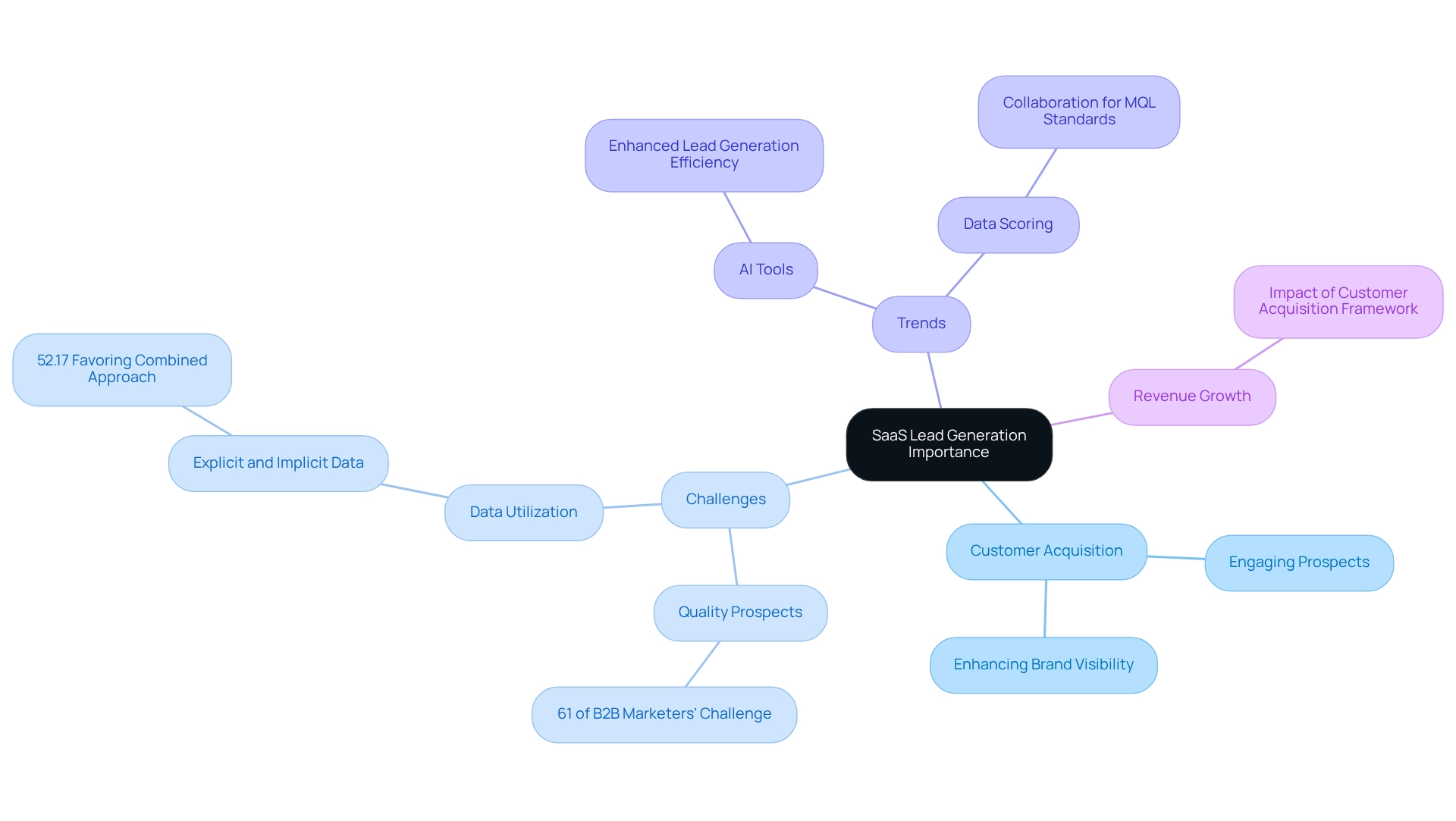
Define Your Target Audience and Ideal Client Profile
Defining your target audience and creating an Ideal Client Profile (ICP) is a vital step in the lead generation process. Start by conducting a market analysis to uncover the demographics, interests, and challenges faced by your prospective clients. We encourage you to utilize tools such as surveys, social media analytics, and client feedback to gather meaningful insights. Once you have this data, create detailed buyer personas that embody your ideal clients. This approach will enable you to tailor your marketing messages and outreach strategies to meet their specific needs. For instance, if your target audience includes small enterprise owners in the tech sector, your messaging should highlight how your SaaS solution can enhance their operations and boost productivity. By truly understanding who your customers are, you can engage them more effectively and significantly increase your chances of conversion.
In 2023, states like Missouri, Wyoming, Delaware, Florida, and Colorado reported the highest rates of , indicating a growing landscape of small enterprises eager for innovative solutions. Furthermore, the computer systems and design industry is projected to create more than 574,000 positions in the coming decade, showcasing the growth potential in the tech sector that small enterprise owners can leverage. It's also important to recognize that only 5% of small businesses reported being fully or partially operated as franchises in 2021, highlighting the independent nature of most small businesses. By focusing on the unique characteristics of your audience, you can enhance your SaaS lead generation by positioning your offering as an essential resource in their growth journey.
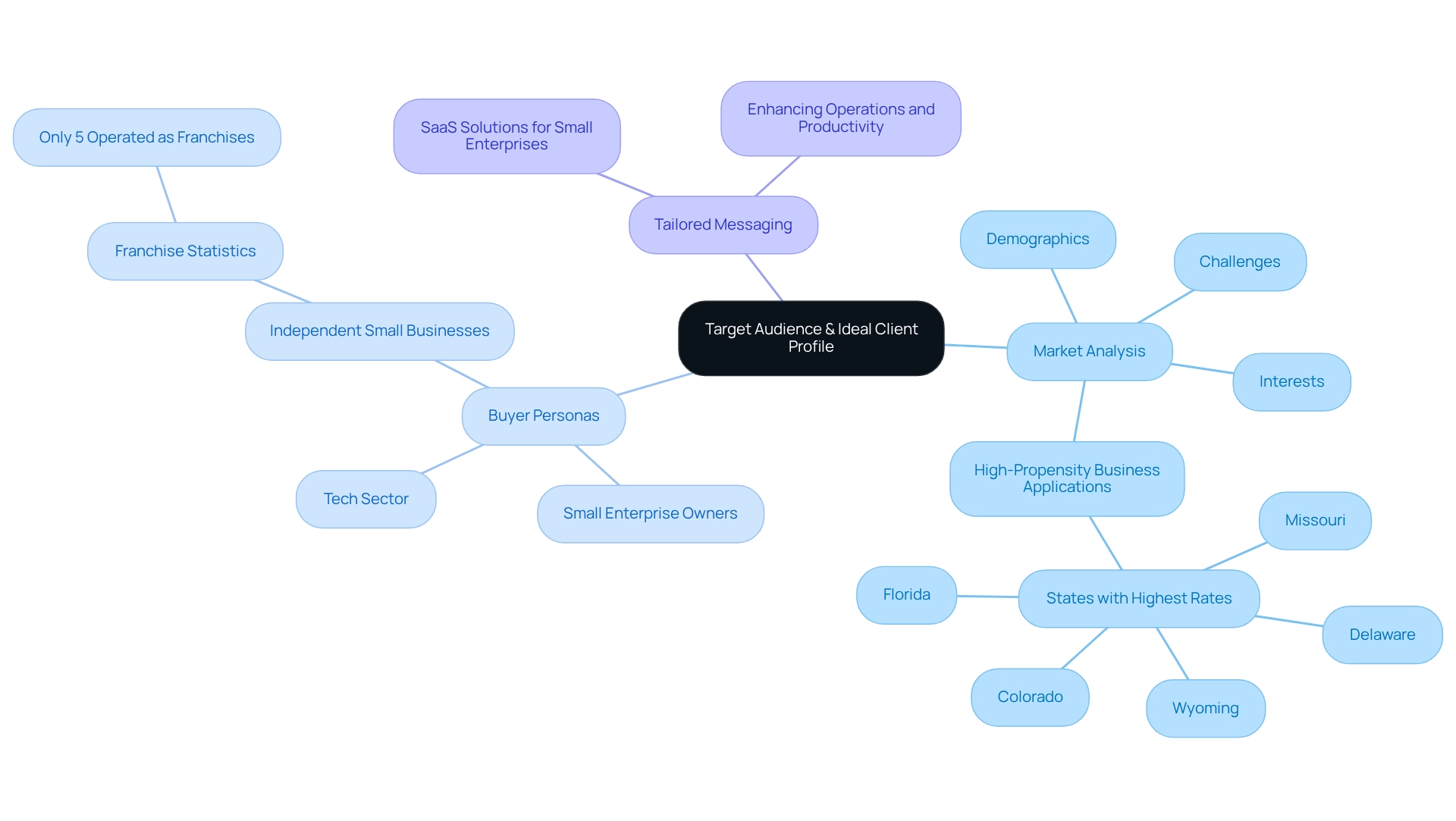
Identify Your Unique Value Proposition
Your (UVP) is a vital statement that articulates the specific benefits your SaaS product offers for SaaS lead generation compared to competitors. To effectively pinpoint your UVP, focus on the issues your product resolves and the value it brings to clients. Ask yourself:
- What sets my product apart?
- Why should clients choose my solution over others?
For instance, if your SaaS platform features advanced automation that significantly reduces manual tasks, this should be a key highlight in your UVP.
A compelling UVP not only attracts potential customers but also nurtures them through the sales funnel by consistently emphasizing the reasons to choose your solution. Research shows that 34% of companies allocate budgets for live event marketing and webinars, highlighting the importance of effectively communicating your UVP in various formats. Make sure your UVP is prominently displayed on your website and in marketing materials to maximize its visibility and impact. By clearly defining and showcasing your UVP, you can enhance customer engagement and drive conversions, ultimately positioning your SaaS product for success in SaaS lead generation within a competitive market. Together, we can achieve this goal and ensure your business thrives.
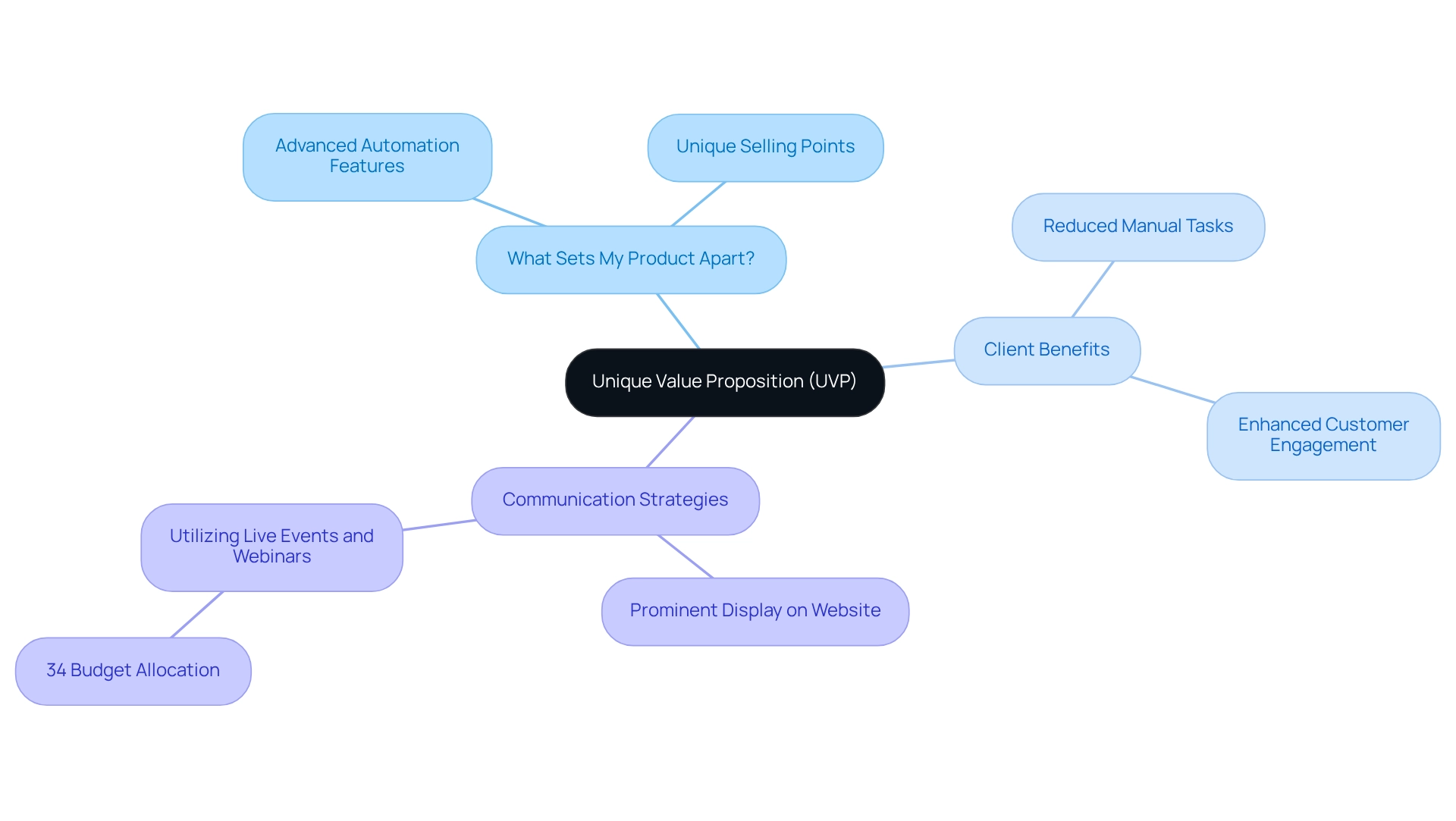
Implement Effective Lead Generation Strategies
To efficiently create prospects, small enterprises should embrace a diverse strategy customized for SaaS lead generation tailored to their target demographic. Here are some proven tactics that can truly make a difference:
- Content Marketing: Developing high-quality content that addresses the specific pain points of your audience is essential. This can include blog posts, whitepapers, and webinars that not only showcase your expertise but also provide actionable solutions. Did you know that nurtured leads make 47% more large purchases? This statistic underscores the importance of delivering valuable content. Additionally, with ad spending in digital audio advertising projected to exceed $12.16 billion by 2025, incorporating audio content into your strategy can further enhance engagement.
- SEO Optimization: Enhancing your website's visibility by optimizing it for search engines is crucial. Utilize relevant keywords, meta tags, and high-quality backlinks to attract organic traffic. Current trends show that effective SEO practices are vital for small businesses aiming to compete in the digital landscape. Together, we can ensure your business stands out.
- Social Media Engagement: Social media platforms are invaluable for forging connections with potential customers. Share engaging content, participate in discussions, and employ targeted advertising to reach your audience effectively. Significantly, 1 in 5 marketers recognize social media as a primary source for attracting clients. Furthermore, 78% of businesses that use social selling outperform those that don’t. This emphasizes the importance of integrating social selling into your approach, as it can truly foster relationships.
- Email Marketing: Cultivating an email list and distributing regular newsletters filled with valuable insights, product updates, and exclusive offers can greatly enhance engagement rates. Customizing your emails makes this a crucial element of your prospect acquisition efforts, allowing you to connect on a personal level.
- Free Trials or Demos: Offering complimentary trials or demos of your SaaS product enables prospective users to experience its value firsthand. This strategy can dramatically enhance conversion rates, particularly through SaaS lead generation, as prospects are more likely to commit after experiencing the product's benefits directly. Additionally, video advertising is gaining traction, with many marketers investing in video ads, recognized for providing a good return on investment.
By diversifying , you can effectively expand your reach and enhance your opportunities for converting prospects into loyal customers. Embracing these tactics will position your small enterprise for growth in the competitive landscape of SaaS lead generation. Remember, we understand your challenges, and together we can achieve success.
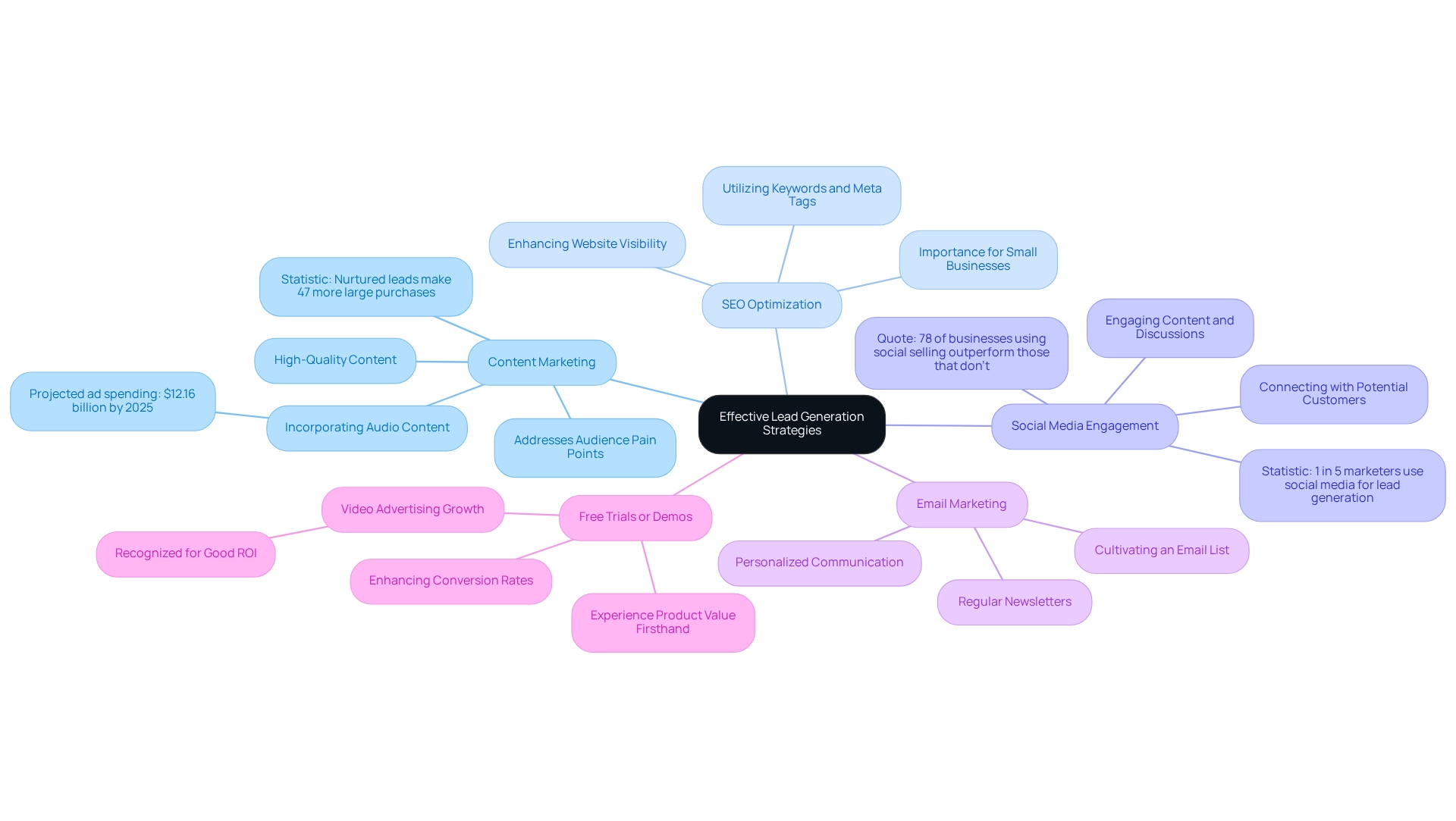
Measure and Analyze Your Lead Generation Results
To enhance the effectiveness of your prospect acquisition strategies, it’s essential to regularly measure and analyze your results. Start by establishing key performance indicators (KPIs) that resonate with your business objectives. Many organizations focus on on their prospecting dashboards, offering a comprehensive view of performance. Here are some essential KPIs for lead generation:
- Conversion Rate: This metric shows the percentage of leads that successfully convert into paying customers, providing valuable insight into the effectiveness of your sales process.
- Cost Per Lead (CPL): Understanding the total expense related to acquiring a prospect helps assess the effectiveness of your marketing strategies and budget distribution.
- Prospect Quality: Evaluate prospects based on their engagement levels and likelihood of conversion, ensuring your attention stays on high-potential candidates.
- Customer Lifetime Value (CLV): This estimate reflects the total revenue a customer is expected to generate throughout their relationship with your business, guiding your long-term strategy.
Alongside these metrics, it’s crucial to prioritize cultivating prospects through personalized communication and sincere attention. AI-driven chatbots have become essential tools for interacting with prospects at all hours, improving the nurturing process.
Utilize analytics tools to track these metrics and gain valuable insights into your prospect acquisition performance. Regularly review and adjust your strategies based on this data. For instance, if a particular channel produces high-quality prospects at a lower expense, consider redistributing resources to enhance that channel’s efficiency. Insights from case studies, such as 'The Rise of AI in Client Acquisition,' demonstrate how AI technologies can enhance scoring, personalization, and automation, transforming client acquisition processes.
By consistently measuring and analyzing your results, you can refine your saas lead generation strategies, leading to improved outcomes and sustained growth. Remember, we understand your challenges, and together, we can achieve success.
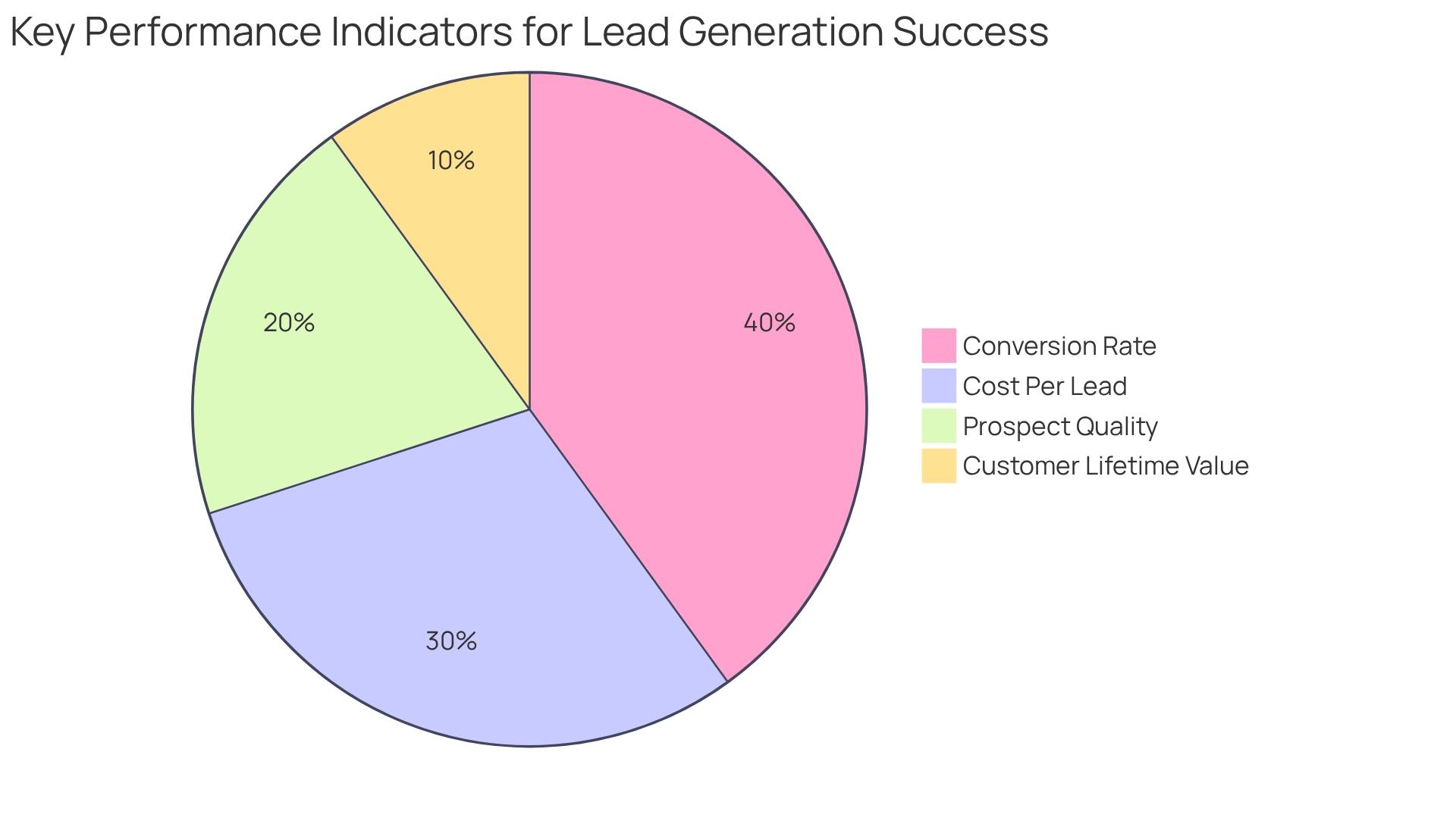
Conclusion
Lead generation is truly the lifeblood of small SaaS businesses, acting as a vital mechanism for customer acquisition and revenue growth. By recognizing the importance of generating quality leads, small enterprises can thoughtfully tailor their strategies to attract and convert potential customers effectively. Identifying target audiences and developing a Unique Value Proposition (UVP) are foundational steps that empower businesses to communicate their offerings in a way that resonates with prospects, ultimately enhancing engagement and conversion rates.
Implementing a variety of lead generation strategies, such as:
- Content marketing
- SEO optimization
- Social media engagement
- Email marketing
- Offering free trials
can significantly broaden a business's reach. Each tactic plays a unique role in nurturing leads through the sales funnel, ensuring that small SaaS companies remain competitive in an ever-evolving digital landscape.
Moreover, the importance of measuring and analyzing lead generation results cannot be overstated. By establishing key performance indicators and utilizing analytics tools, businesses can gain valuable insights into their lead generation performance, allowing for continuous refinement of strategies. This proactive approach not only maximizes lead quality but also fosters long-term relationships with customers, paving the way for sustained growth and success in the SaaS sector. In this dynamic environment, embracing innovative strategies and technologies will be essential for small businesses aiming to thrive and stand out in a crowded marketplace. Together, we can navigate these challenges and achieve lasting success.
Frequently Asked Questions
Why is lead generation important for SaaS companies?
Lead generation is crucial for SaaS companies as it helps attract and transform strangers into engaged prospects, which is essential for expanding clientele and enhancing brand visibility. It drives customer acquisition and enhances credibility, contributing to ongoing success.
What challenges do B2B marketers face regarding lead generation?
According to 61% of B2B marketers, the primary challenge they face is obtaining quality prospects, highlighting the need for refined lead generation strategies.
How can small businesses utilize online platforms for lead generation?
Small businesses can leverage online platforms for SaaS lead generation to attract potential customers, allowing them to compete effectively with larger companies in the market.
What role do AI tools play in SaaS lead generation?
AI tools enhance the efficiency of SaaS lead generation by allowing for more targeted outreach and improved conversion rates. Many companies use a combination of explicit and implicit data for scoring prospects.
What is the significance of defining a target audience and creating an Ideal Client Profile (ICP)?
Defining a target audience and creating an ICP is vital as it helps in understanding the demographics, interests, and challenges of prospective clients, enabling tailored marketing messages and outreach strategies that meet their specific needs.
How can businesses gather insights to define their target audience?
Businesses can gather insights through market analysis, surveys, social media analytics, and client feedback to understand their prospective clients better.
What are buyer personas, and why are they important?
Buyer personas are detailed representations of ideal clients based on gathered data. They are important because they help businesses tailor their marketing efforts effectively, increasing the chances of conversion.
What trends are observed in small enterprise applications in 2023?
States like Missouri, Wyoming, Delaware, Florida, and Colorado reported high rates of high-propensity enterprise applications, indicating a growing landscape of small enterprises seeking innovative solutions.
What growth potential exists in the tech sector for small enterprises?
The computer systems and design industry is projected to create over 574,000 positions in the coming decade, showcasing significant growth potential for small enterprises in the tech sector.
What percentage of small businesses were reported as franchises in 2021?
Only 5% of small businesses reported being fully or partially operated as franchises in 2021, indicating the independent nature of most small businesses.




